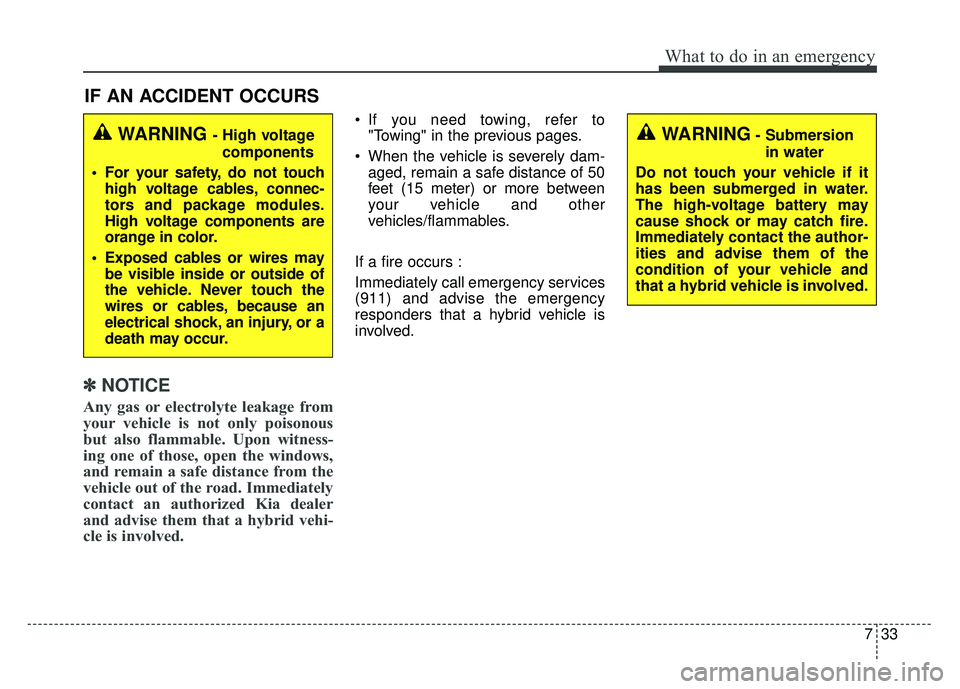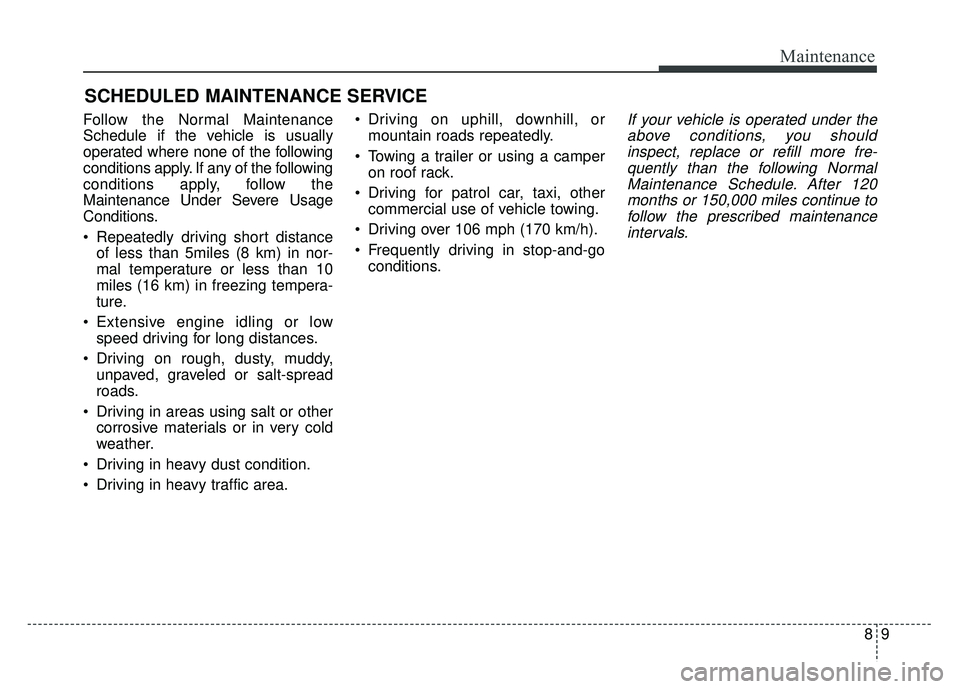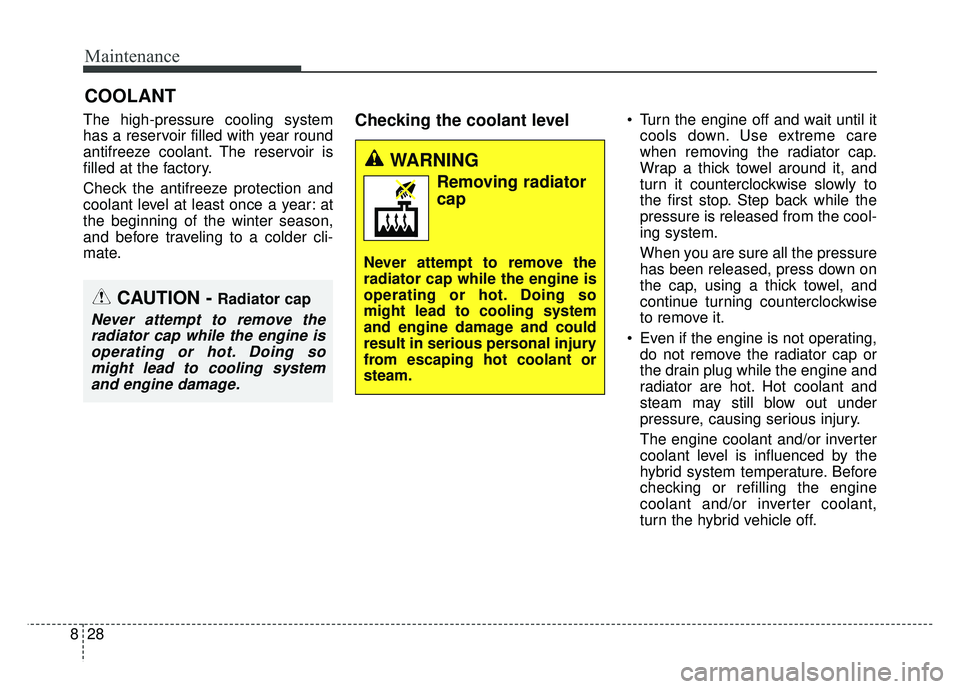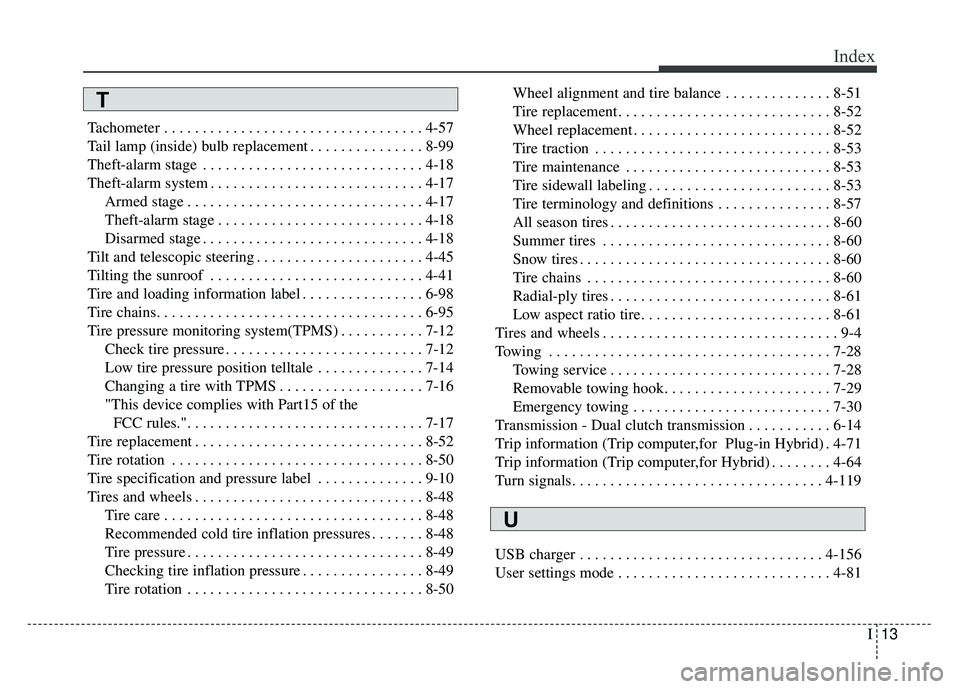tow KIA NIRO PHEV 2018 Workshop Manual
[x] Cancel search | Manufacturer: KIA, Model Year: 2018, Model line: NIRO PHEV, Model: KIA NIRO PHEV 2018Pages: 616, PDF Size: 18.3 MB
Page 469 of 616

733
What to do in an emergency
IF AN ACCIDENT OCCURS
✽
✽ NOTICE
Any gas or electrolyte leakage from
your vehicle is not only poisonous
but also flammable. Upon witness-
ing one of those, open the windows,
and remain a safe distance from the
vehicle out of the road. Immediately
contact an authorized Kia dealer
and advise them that a hybrid vehi-
cle is involved.
If you need towing, refer to
"Towing" in the previous pages.
When the vehicle is severely dam- aged, remain a safe distance of 50
feet (15 meter) or more between
your vehicle and other
vehicles/flammables.
If a fire occurs :
Immediately call emergency services
(911) and advise the emergency
responders that a hybrid vehicle is
involved.
WARNING - High voltage components
For your safety, do not touch high voltage cables, connec-
tors and package modules.
High voltage components are
orange in color.
Exposed cables or wires may be visible inside or outside of
the vehicle. Never touch the
wires or cables, because an
electrical shock, an injury, or a
death may occur.WARNING- Submersion
in water
Do not touch your vehicle if it
has been submerged in water.
The high-voltage battery may
cause shock or may catch fire.
Immediately contact the author-
ities and advise them of the
condition of your vehicle and
that a hybrid vehicle is involved.
Page 478 of 616

89
Maintenance
SCHEDULED MAINTENANCE SERVICE
Follow the Normal Maintenance
Schedule if the vehicle is usually
operated where none of the following
conditions apply. If any of the following
conditions apply, follow the
Maintenance Under Severe Usage
Conditions.
Repeatedly driving short distanceof less than 5miles (8 km) in nor-
mal temperature or less than 10
miles (16 km) in freezing tempera-
ture.
Extensive engine idling or low speed driving for long distances.
Driving on rough, dusty, muddy, unpaved, graveled or salt-spread
roads.
Driving in areas using salt or other corrosive materials or in very cold
weather.
Driving in heavy dust condition.
Driving in heavy traffic area. Driving on uphill, downhill, or
mountain roads repeatedly.
Towing a trailer or using a camper on roof rack.
Driving for patrol car, taxi, other commercial use of vehicle towing.
Driving over 106 mph (170 km/h).
Frequently driving in stop-and-go conditions.If your vehicle is operated under theabove conditions, you shouldinspect, replace or refill more fre-quently than the following NormalMaintenance Schedule. After 120months or 150,000 miles continue tofollow the prescribed maintenanceintervals.
Page 490 of 616

821
Maintenance
Maintenance Under Severe Usage Conditions
Severe Driving Conditions
A - Repeatedly driving short distance of less than 5 miles (8 km) in nor-mal temperature or less than 10 miles (16 km) in freezing temperature
B - Extensive engine idling or low speed driving for long distances
C - Driving on rough, dusty, muddy, unpaved, graveled or salt- spread roads
D - Driving in areas using salt or other corrosive materials or in very cold weather E - Driving in heavy dust condition.
F - Driving in heavy traffic area.
G - Driving on uphill, downhill, or mountain roads repeatedly.
H - Towing a trailer or using a camper on roof rack.
I - Driving for patrol car, taxi, other commercial use of vehicle towing.
J - Driving over 106 mph (170 km/h).
K - Frequently driving in stop-and-go conditions.
The following items must be serviced more frequently on cars normally used under severe driving conditions. Refer
to the chart below for the appropriate maintenance intervals.
R : Replace I : Inspect and, after inspection, clean, adjust, repair or replace if neces\
sary
MAINTENANCE ITEMMAINTENANCE
OPERATIONMAINTENANCE INTERVALSDRIVING CONDITION
Engine oil and filter REvery 3,750 miles (6,000 km) or 6 monthsA, B, C, D, E, F, G,
H, I, J, K
Air cleaner filterRMore frequentlyC, E
Spark plugsRMore frequentlyB, H
Dual clutch transmission fluid REvery 75,000 miles (120,000 km)C, D, E, F, G, H, I, J
HSG (Hybrid Starter & Generator) beltREvery 30,000 miles (48,000 km) or 24 monthsC, D, E, K
IEvery 3,750 miles (6,000 km) or 6 monthsC, D, E, K
Front brake disc/pads, calipersIMore frequentlyC, D, G, H
Rear brake disc/padsIMore frequentlyC, D, G, F
Parking brakeIMore frequentlyC, D, G, H
Steering gear box, linkage & boots/lower arm ball
joint, upper arm ball jointIMore frequentlyC, D, E, F, G, H, I
Drive shafts and bootsIEvery 7,500 miles (12,000 km) or 6 monthsC, D, E, F, G, H, I, J
Climate control air filter
(for evaporator and blower unit)RMore frequentlyC, E
Suspension mounting boltsIMore frequentlyC, D, E, F, G, H, I
Page 497 of 616

Maintenance
28
8
COOLANT
The high-pressure cooling system
has a reservoir filled with year round
antifreeze coolant. The reservoir is
filled at the factory.
Check the antifreeze protection and
coolant level at least once a year: at
the beginning of the winter season,
and before traveling to a colder cli-
mate.Checking the coolant level Turn the engine off and wait until it
cools down. Use extreme care
when removing the radiator cap.
Wrap a thick towel around it, and
turn it counterclockwise slowly to
the first stop. Step back while the
pressure is released from the cool-
ing system.
When you are sure all the pressure
has been released, press down on
the cap, using a thick towel, and
continue turning counterclockwise
to remove it.
Even if the engine is not operating, do not remove the radiator cap or
the drain plug while the engine and
radiator are hot. Hot coolant and
steam may still blow out under
pressure, causing serious injury.
The engine coolant and/or inverter
coolant level is influenced by the
hybrid system temperature. Before
checking or refilling the engine
coolant and/or inverter coolant,
turn the hybrid vehicle off.
WARNING
Removing radiator
cap
Never attempt to remove the
radiator cap while the engine is
operating or hot. Doing so
might lead to cooling system
and engine damage and could
result in serious personal injury
from escaping hot coolant or
steam.
CAUTION - Radiator cap
Never attempt to remove theradiator cap while the engine isoperating or hot. Doing somight lead to cooling systemand engine damage.
Page 614 of 616

I13
Index
Tachometer . . . . . . . . . . . . . . . . . . . . . . . . . . . . . . . . . . 4-57\
Tail lamp (inside) bulb replacement . . . . . . . . . . . . . . . 8-99
Theft-alarm stage . . . . . . . . . . . . . . . . . . . . . . . . . . . . . 4-18
Theft-alarm system . . . . . . . . . . . . . . . . . . . . . . . . . . . . 4-17Armed stage . . . . . . . . . . . . . . . . . . . . . . . . . . . . . . . 4-17
Theft-alarm stage . . . . . . . . . . . . . . . . . . . . . . . . . . . 4-18
Disarmed stage . . . . . . . . . . . . . . . . . . . . . . . . . . . . . 4-18
Tilt and telescopic steering . . . . . . . . . . . . . . . . . . . . . . 4-45
Tilting the sunroof . . . . . . . . . . . . . . . . . . . . . . . . . . . . 4-41
Tire and loading information label . . . . . . . . . . . . . . . . 6-98
Tire chains. . . . . . . . . . . . . . . . . . . . . . . . . . . . . . . . . . . 6-\
95
Tire pressure monitoring system(TPMS) . . . . . . . . . . . 7-12 Check tire pressure . . . . . . . . . . . . . . . . . . . . . . . . . . 7-12
Low tire pressure position telltale . . . . . . . . . . . . . . 7-14
Changing a tire with TPMS . . . . . . . . . . . . . . . . . . . 7-16
"This device complies with Part15 of the FCC rules.". . . . . . . . . . . . . . . . . . . . . . . . . . . . . . . 7-17
Tire replacement . . . . . . . . . . . . . . . . . . . . . . . . . . . . . . 8-52
Tire rotation . . . . . . . . . . . . . . . . . . . . . . . . . . . . . . . . . 8-50
Tire specification and pressure label . . . . . . . . . . . . . . 9-10
Tires and wheels . . . . . . . . . . . . . . . . . . . . . . . . . . . . . . 8-48 Tire care . . . . . . . . . . . . . . . . . . . . . . . . . . . . . . . . . . 8-48\
Recommended cold tire inflation pressures . . . . . . . 8-48
Tire pressure . . . . . . . . . . . . . . . . . . . . . . . . . . . . . . . 8-49
Checking tire inflation pressure . . . . . . . . . . . . . . . . 8-49
Tire rotation . . . . . . . . . . . . . . . . . . . . . . . . . . . . . . . 8-50 Wheel alignment and tire balance . . . . . . . . . . . . . . 8-51
Tire replacement . . . . . . . . . . . . . . . . . . . . . . . . . . . . 8-52
Wheel replacement . . . . . . . . . . . . . . . . . . . . . . . . . . 8-52
Tire traction . . . . . . . . . . . . . . . . . . . . . . . . . . . . . . . 8-53
Tire maintenance . . . . . . . . . . . . . . . . . . . . . . . . . . . 8-53
Tire sidewall labeling . . . . . . . . . . . . . . . . . . . . . . . . 8-53
Tire terminology and definitions . . . . . . . . . . . . . . . 8-57
All season tires . . . . . . . . . . . . . . . . . . . . . . . . . . . . . 8-60
Summer tires . . . . . . . . . . . . . . . . . . . . . . . . . . . . . . 8-60
Snow tires . . . . . . . . . . . . . . . . . . . . . . . . . . . . . . . . . 8-60
Tire chains . . . . . . . . . . . . . . . . . . . . . . . . . . . . . . . . 8-60
Radial-ply tires . . . . . . . . . . . . . . . . . . . . . . . . . . . . . 8-61
Low aspect ratio tire. . . . . . . . . . . . . . . . . . . . . . . . . 8-61
Tires and wheels . . . . . . . . . . . . . . . . . . . . . . . . . . . . . . . 9-4
Towing . . . . . . . . . . . . . . . . . . . . . . . . . . . . . . . . . . . . \
. 7-28 Towing service . . . . . . . . . . . . . . . . . . . . . . . . . . . . . 7-28
Removable towing hook. . . . . . . . . . . . . . . . . . . . . . 7-29
Emergency towing . . . . . . . . . . . . . . . . . . . . . . . . . . 7-30
Transmission - Dual clutch transmission . . . . . . . . . . . 6-14
Trip information (Trip computer,for Plug-in Hybrid) . 4-71
Trip information (Trip computer,for Hybrid) . . . . . . . . 4-64
Turn signals. . . . . . . . . . . . . . . . . . . . . . . . . . . . . . . . . 4-119
USB charger . . . . . . . . . . . . . . . . . . . . . . . . . . . . . . . . 4-156
User settings mode . . . . . . . . . . . . . . . . . . . . . . . . . . . . 4-81
T
U